Brief communication |
Peer reviewed |
The influence of canine teeth clipping on nursing and nursery pig performance
Ronald O. Bates, MS, PhD; Mark D. Hoge, MS; David B. Edwards, MS; Barbara E. Straw, DVM, PhD
ROB, MDH, DBE: Department of Animal Science, Anthony Hall, Michigan State University, East Lansing, MI 48824-1225. BES: Department of Large Animal Clinical Sciences, Michigan State University, East Lansing, MI 48824-1225.
Bates RO, Hoge MD, Edwards DB, et al. The influence of canine teeth clipping on nursing and nursery pig performance. J Swine Health Prod. 2003;11(2):75-79. Also available as a PDF
Summary
Litters that either had their canine teeth clipped or left intact had similar preweaning and nursery growth and mortality rates, although pigs with intact teeth had more facial wounds than those with clipped teeth. Clipping canine teeth is not routinely necessary for modern swine farms.
Keywords: swine, piglet, canine teeth, growth, mortality rate
Received: December 11, 2001
Accepted: February 11, 2002
Clipping canine or needle teeth of newborn piglets has been a longtime standard practice in pork production, in an attempt to reduce piglet injury and infection from fighting among litter mates for access to a functional nipple, and to reduce injury to the udder of the sow.1 Even though sow milking ability has improved, routine canine teeth clipping has remained a suggested management practice.2 However, it has been reported that clipping canine teeth, as well as other piglet processing procedures, does cause distress and may influence performance.3 One study reported that allowing low birth weight piglets to maintain their canine teeth improved their growth performance and decreased mortality rate.4 Another study suggested that in large litters, pigs with intact teeth had improved weight gain compared to litters that had clipped canine teeth.5
These reports suggest that clipping canine teeth may be unnecessary for litters nursing sows with an adequate milk supply and number of nipples. Unfortunately, these reports do not elucidate the impact of not clipping canine teeth under commercial conditions, nor did they examine any residual effect that may be inherent after weaning. Our objective was to determine the effect of not clipping canine teeth on nursing pig performance, pre-weaning mortality rate, and subsequent nursery performance in a commercial herd typical of modern swine production systems.
Materials and methods
Study animals and treatment groups
This study was performed at a commercial 1500-sow farrow-to-wean site in Michigan, in which sows gestated in outside group housing and farrowed and lactated in individual farrowing stalls in environmentally controlled rooms. Each room held approximately 65 sows, which represented one week’s farrowing. Females were either two thirds Yorkshire and one third Landrace or two thirds Landrace and one third Yorkshire. Landrace or Yorkshire boars were used to produce litters from which gilt replacements would be selected (maternal line), and crossbred boars were used to sire litters intended for market (terminal line).
This study included 318 sows and their litters (3184 pigs) from five consecutive weekly farrowing groups. Within each weekly farrowing group, females were randomly allocated, within parity and litter genetic line (maternal or terminal), to either have their litter’s canine teeth clipped or have them remain intact. Parity classifications were the following: Parity 1, first litter females; Parity 2 to 5, females farrowing their second through fifth litters; Parity 6+, females farrowing their sixth or greater litters. The numbers of piglets by treatment and parity subclass are listed in Table 1.

Processing of piglets and scoring of face lesions
Litters were processed by the investigators within 24 hours after farrowing. Processing consisted of tail docking, ear notching, castration, injectable iron supplementation, and canine teeth clipping if so designated. Side cutters were used to remove the distal two thirds of the tooth, taking care not to fracture teeth, injure gums, nor leave any rough points. At processing, each pig had a unique numbered ear tag placed in one ear and was individually weighed. Pigs that were near death at processing were not tagged nor included in this study. Within the first 3 to 4 days after birth, pigs were cross fostered within treatment, and cross fostering was recorded. Investigators recorded mortalities daily, and when pigs were 3 days of age, sketched the wounds on each pig’s face on a diagram which was later converted to a numerical score. Scores were assigned as follows: 0, no wounds; 1, one to three linear lacerations (scratches); 2, four to six scratches; 3, more than six scratches, or one to three scratches plus a circular area of eroded skin <1 cm in diameter; 4, an erosion >1 cm with up to four scratches; and 5, more severe lesions. Farm personnel and the consulting farm veterinarian administered health management procedures for injury or illness.
Four days before weaning, when the average piglet age was 13.0 +/- 2.1 days old, all pigs were individually weighed (13-day weight) and their faces were again scored for facial wounds. At weaning, pigs were moved into off-site nurseries and penned by treatment and sex. Prior to moving to finishers, 2363 pigs were weighed (final nursery weight) to determine nursery weight gain. On average, the time between the 13-day weight and the final nursery weight was 48.7 +/- 1.2 days.
Statistical analyses
Production data compared for the two treatments included nursing weight gain (gain from birth to 13-day weight), nursing weight gain variability, mortality rate from birth to 13-day weight, nursery weight gain (weight gain from 13-day weight to final nursery weight), variability of nursery weight gain, and final nursery weight.
The F-test was used to test for equal variances in nursing and nursery weight gain between treatments. To test for possible differences in the variability of nursing and nursery weight gain, the within-treatment variance estimates were used to calculate a ratio of within-treatment variances, and the ratio was compared to the appropriate F distribution to determine significance (Table 2).
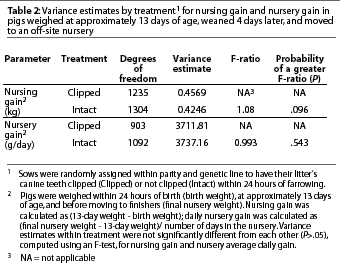
Growth data were analyzed using least squares analysis of variance (ANOVA). Terms in the analysis of variance table were farrowing week, treatment, piglet gender, sow parity, sire breed of litter, litter size, piglet birth weight, days from birth to 13-day weight, and all two-way interactions. Data were organized into a randomized block design with farrowing week used as the blocking variable.
Due to the categorical nature of piglet mortality rate and 3-day and 13-day face scores, logistical regression was used to analyze these data. Terms in the model included farrowing week, sow parity, treatment, nursing litter size, gender, and all two-way interactions. Litter size was classified into three categories for these analyses: fewer than ten, ten, and more than ten nursing piglets, determined after cross fostering. Only main effects were included in the models to analyze face scores because there were few observations per subclass or empty subclassification categories for interaction effects.
For all analyses, linear orthogonal comparisons were used to determine significant treatment effects.
Results
Not all pigs weaned were included in the nursery performance summary. Due to scale malfunction, 195 barrows from the first farrowing week were not weighed for final nursery weight. In addition, another 276 were not available for this project. However, for those pigs not included in the nursery summary, no treatment difference existed for 13-day weight, thus estimation of treatment differences of nursery growth rate was not biased by treatment differences for initial weight.
Estimated variances within treatment for weight gain are shown in Table 2. Variance estimates within treatment did not differ (P>.05) for nursing gain and nursery average daily gain. Nursing piglet performance is reported in Table 3. Nursing weight gain and 13-day weight were similar for each treatment. Parity differences were significant for nursing pig gain and 13-day weight. Pigs from Parity 1 sows gained 0.1 kg less weight while nursing than pigs from older parity sows. The same was true for 13-day weight: pigs from Parity 1 sows were 0.2 kg lighter than pigs from older parity sows.
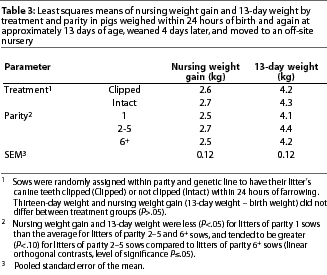
There was a significant parity by treatment interaction for nursing mortality rate (Figure 1). For litters nursing Parity 6+ sows, the mortality rate was higher (P<.001) for pigs with clipped teeth (13.2%) than for pigs with intact teeth (4.0%). There was a trend within Parity 1 for the mortality rate to be higher (P<.1) for pigs with clipped teeth (15.2%) than for pigs with intact teeth (10.5%). Mortality rates did not differ between treatments for pigs nursing Parity 2-5 females. Face scores at day 3 and 13 of lactation are shown in Figures 2 and 3, respectively. Pigs with intact canine teeth had higher (P <.001) face scores than pigs with clipped teeth at both 3 and 13 days. Nursery performance is reported in Table 4. Treatment differences were not signifi-cant for either nursery weight gain or ending nursery weight.
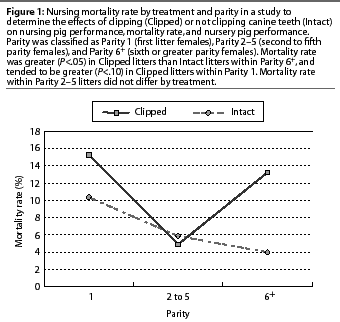

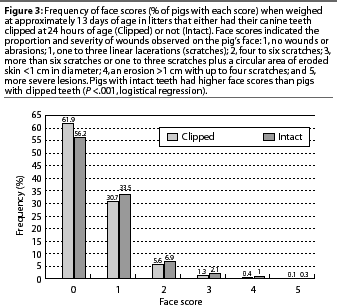
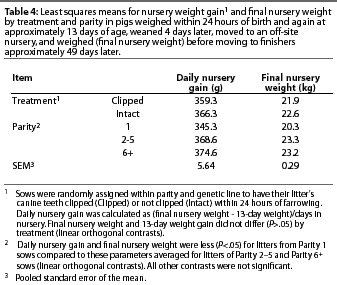
Discussion
Management practices within modern swine production are a combination of methods carried forward over time and those scientifically proven to be necessary. However, all management practices should be routinely assessed as to their need and impact on the daily work schedule, as well as to the health and well-being of the pig. This study evaluated the relevance of a long-standing management practice on a modern swine farm.
Within this study, the variability for nursing and nursery weight gain between pigs with clipped or intact teeth was not significantly different. This indicates that the range in performance was similar between the two treatments. This does conflict with a report4 that compared litters in which all pigs had their canine teeth clipped to litters in which higher birth weight piglets had their teeth clipped and lower birth weight piglets within the litter did not. This study reported that the variance for litter 21-day weight was 15% smaller for litters in which lower birth weight pigs had intact canine teeth compared to litters in which all pigs had canine teeth clipped.
Nursing weight gain was similar between pigs with either intact or clipped canine teeth. This is in general agreement with several reports,6-8 but conflicted with others. 4,5 Two of the reports in agreement with results presented here6-8 also suggested that weight gain between 3 days and 1 week of age was better for pigs which had their canine teeth intact compared to those which had their canine teeth clipped; however, in both reports, this improvement did not persist through 3 weeks of age. Fraser and Thompson5 reported an interaction of litter size with canine teeth clipping. Litters of eight and ten piglets had similar weight gain from birth to 21 days when their canine teeth were or were not clipped. However, piglets in litters of 12 with intact canine teeth grew faster than piglets in litters of 12 that had canine teeth clipped. Robert et al4 also reported an interaction of treatment with litter size and birth weight class. Treatments in that study were litters in which all pigs had clipped canine teeth compared to litters in which higher birth weight pigs had clipped canine teeth while lower birth weight pigs had intact canine teeth. Lower birth weight pigs in litters of nine to 11 achieved the greatest rate of gain when their teeth were left intact. However, treatment differences were not significantly different for pigs in litters of either six to eight or 12 to 14 piglets. In the present study, the interaction of litter size and treatment was not significant, in conflict with two of the aforementioned reports.4,5
In this study, nursing weight gain and 13-day weight were lower for pigs nursing Parity 1 females. Historically, it has been shown that litter weight at 21 days of lactation is lower for first parity females than later parity females.9-11
There was a treatment interaction for nursing mortality rate. Nursing mortality rate was higher for pigs with clipped canine teeth that nursed older dams, compared to pigs with intact teeth that nursed older dams. A similar trend was evident for pigs nursing Parity 1 dams: there was a tendencyfor mortality rate to be higher in pigs with clipped canine teeth than in pigs with intact teeth. These results somewhat conflict with those of other studies,4.6 which reported mortality rate differences among pigs with either clipped or intact canine teeth. Hartsock et al6 reported similar mortality rates between pigs with intact or clipped canine teeth. However, Robert et al4 reported a treatment by birth weight by litter size interaction. Lower birth weight piglets in litters of 12 to 14 with intact teeth had lower nursing mortality rate (32.0%) than low birth weight pigs with clipped teeth in litters of 12 to 14 (39.8%). However, no other treatment by litter size by birth weight comparisons were significantly different, and overall nursing mortality rate was 13% in that study.
Even though piglet performance was similar between pigs with either intact or clipped canine teeth, those with intact canine teeth had a higher likelihood of facial wounds. This is consistent with other studies4,7,8 that reported more facial wounds in pigs with intact canine teeth than in those with clipped canine teeth. However, this trauma did not affect performance and had no detrimental impact on mortality; in some cases, mortality was lower when pigs had intact canine teeth.
Similar to nursing pig performance, no treatment differences were significant for nursery growth rate. This is somewhat in disagreement with a report4 in which 56-day weight was higher for low birth weight pigs with intact canine teeth than for low birth weight pigs with clipped teeth.
Parity did affect nursery performance. Pigs from Parity 1 dams had slower growth rate and were lighter at completion of the nursery period than pigs from older dams.
On the basis of the results of our study and the majority of other reported studies, canine tooth clipping of pigs in modern swine production systems does not result in reduced mortality rate or enhanced growth rate. In fact, our study indicates reduced mortality in Parity 1 and Parity 6+ litters when piglet canine teeth were left intact.
Implications
- Variability of nursing and nursery growth for pigs with either intact or clipped canine teeth was not significantly different under the conditions of this study in a commercial farrow-to-wean facility.
- Nursing and nursery growth rate were similar between pigs with clipped or intact canine teeth.
- Nursing mortality rate was lower among pigs with intact canine teeth nursing either first parity dams or dams of parity 6 or greater.
- Pigs with intact canine teeth had more facial abrasions than pigs with clipped teeth; however, this did not influence growth rate.
- Not clipping canine teeth should reduce labor needs for farrowing procedures and allow a shift of labor resources to other higher priority duties.
Acknowledgement
The authors wish to thank Barton Farms, Homer, Michigan, for cooperating in this study, and Chandra Nielson and Christine Bunner for their assistance in data collection.References – refereed
1.Krider JL, Carroll WE. Swine Production. 4th ed. New York: McGraw-Hill Book Co. 1971;160-192.
3. Noonan GJ, Rand JS, Priest J, Ainscow J, Blackshaw JK. Behavioral observations of piglets undergoing tail docking, teeth clipping and ear notching. Appl Anim Behav Sci. 1994; 39:203-213.
4. Robert S, Thompson BK, Fraser D. Selective tooth clipping in the management of low-birth-weight piglets. Can J Anim Sci. 1995; 75:285-289.
5. Fraser D, Thompson BK. Armed sibling rivalry among suckling piglets. Behav Ecol Sociobiol. 1991;29:9-15.
7. Brown JME, Edwards SA, Smith WJ, Thompson E, Duncan J. Welfare and production implications of teeth clipping and iron injection of piglets in outdoor systems in Scotland. Prev Vet Med. 1995;27:95-105.
8. Weary DM, Fraser D. Partial tooth-clipping of suckling pigs: effects on neonatal competition and facial injuries. Appl Anim Behav Sci. 1999;65:21-27.
9. Wilson ER, Johnson RK. Adjustment of 21 day litter weight for number of pigs nursed and purebred and crossbred dams. J Anim Sci; 1980.51:37-42.
10. Wood CM, Christian LL, Rothchild M. Factors to adjust litter weight of pigs to a standard 21 days of age. J Anim Sci. 1990;68:2628-2633.
11. Culbertson MS. Mabry JW, Bertrand JK, Nelson AH. Breed-specific adjustment factors for reproductive traits in Duroc, Hampshire, Landrace and Yorkshire swine. J Anim Sci. 1997;75:2362-2367.
References – non refereed
2. Reese DE, Hartsock TG, Morrow WEM. Baby pig management – birth to weaning. W Lafayette Indiana: Purdue University. Pork Industry Handbook No 18; 1999.
6. Hartsock TG. Effect of needle teeth on fighting behavior of newborn pig [abstract]. Can J Anim Sci. 1976;56:834.